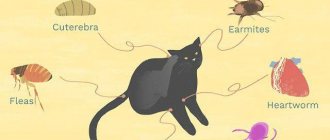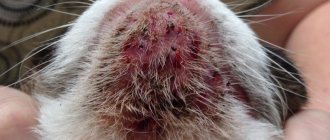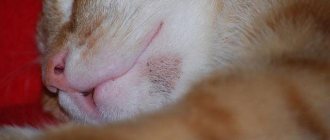There is an opinion that if a pet does not go outside, it cannot have worms. But veterinary practice confirms the presence of helminthiasis in 40% of domestic cats. This means that there are actually more ways of becoming infected with parasites.
Information about possible methods of infection with helminths will help prevent the development of diseases and even save the life of your pet.
Where does a cat get worms?
Not only stray animals can become infected with helminthiasis. Worms occur quite often in cats that live in apartments and private houses. Of course, free-ranging pets are at greatest risk of infection. Helminth eggs can be found on grass, sand and soil. They remain on the fur, and when the cat licks itself, it enters the digestive tract.
A person can bring parasite eggs into an apartment on his shoes or clothes.
There are other ways of infection with helminthic infestation:
- Eating raw river fish, meat and minced meat.
- Close contact with an infected animal. Helminth infections are transmitted by using a common tray or equipment.
- Some types of worms are transmitted to kittens through the milk of a nursing mother.
- Fleas and lice eaters are carriers of helminthiasis. If a cat has ectoparasites, the risk of infection with worms cannot be ruled out.
Types of helminths in cats
Worms that parasitize cats are divided into several groups:
- Roundworms. Otherwise they are called nematodes.
- Tapeworms (flatworms), or cestodes.
- Flukes are trematodes.
Round (nematodes)
The most common roundworm in cats is roundworms. There are two types of such worms:
- Toxocara cati;
- Toxacaris leonine.
These are light yellow cylindrical worms. Outwardly they look like spaghetti. The average length of these parasites is 7-15 cm. Roundworms settle primarily in the small intestine.
Hookworms are another type of helminthic infestation in cats. The size of parasites usually does not exceed 10 mm. These worms can even enter an animal's body through the skin. Habitat: small intestine.
Heartworms - this type of worms in cats is transmitted by mosquitoes during a bite. These worms can infect the subcutaneous tissue, muscle tissue, heart and lungs. The size of adult individuals reaches 30 cm in length.
Routes of infection
Roundworm eggs enter the body of cats mainly through nutrition:
- when eating raw meat and fish;
- while licking paws and fur.
The source of infection is most often sick animals, which release parasite eggs along with feces into the environment. Worms in a kitten can appear due to an infected mother who feeds her babies with breast milk.
Why are they dangerous?
Roundworms injure the intestinal mucosa and release toxic substances. This leads to poisoning of the body. In addition, they take away some of the cat's nutrients. As a result, exhaustion, anemia occurs, and the body's protective functions decrease. With ascariasis, blockage of the bile ducts and intestinal obstruction are possible.
How to notice
Signs of the presence of roundworms in cats are not immediately detected. Symptoms appear 2-4 weeks after infection. How to understand that your pet has helminths:
- the cat loses its appetite and loses weight;
- Allergic skin rashes may appear;
- diarrhea and constipation occur from time to time;
- there may be blood in the stool;
- the coat loses its well-groomed appearance and looks dull.
With dirofilariasis, the symptoms are specific - shortness of breath, fatigue, swelling. This clinical picture emerges if worms have affected the heart. In the ocular form of the disease, the eyelids become inflamed. If the worms have settled in the subcutaneous tissue, moving formations, ulcers are found on the body, and the hair in these places falls out.
Tape (cestodes)
This group includes worms with a flat body that looks like a ribbon, hence the name. The length of parasites can reach 70 cm. Their oral cavity is equipped with hooks. With their help, worms attach to the intestinal mucosa. As the worms grow, segments about the size of a grain of rice break off from the back of the worm and are passed in the infected animal's feces.
There are several types of tapeworms in cats:
- Cucumber tapeworm. The parasite reaches 50 cm in length and about 3 mm in width. The worm has 4 suckers and a proboscis with spine-like hooks. Its segments resemble cucumber seeds. The tapeworm is a parasite in the small intestine.
- Wide tape. The length of the worm can reach several meters. The intermediate hosts of the tapeworm are copepods and fish.
- Echinococcal tapeworm. These are worms no larger than 4 mm, the larvae of which live in the intestines of cats and dogs. Man, along with other animals, is an intermediate host of Echinococcus.
How do pets become infected?
Tapeworms enter a cat's body in a variety of ways. For example:
- cucumber tapeworm - when ingesting an infected flea or lice eater;
- wide tapeworm - when eating raw river fish;
- Infection with echinococcosis is possible through contact with the feces of a sick animal.
What is the danger
Tapeworms are dangerous to both cats and their owners. They injure the intestinal mucosa and poison the body with the products of their vital activity. Severe infection can cause anemia and blockage of the intestinal lumen.
Attention! A person can become infected with cestodosis from a sick cat if he does not follow the rules of personal hygiene - does not wash his hands after contact with the animal or touches fur contaminated with feces with his lips.
How to see
You can tell that a cat has tapeworms by the following signs:
- segments of helminths are occasionally found in feces;
- the cat has poor appetite;
- vomiting, diarrhea;
- allergic rashes;
- irritation in the anal area;
- apathy, fatigue.
Flukes (trematodes)
These are flat worms that are firmly attached to the cat’s internal organs using powerful suction cups. They can parasitize the liver, bile ducts and lungs. During their life, worms gradually destroy the tissues of internal organs.
The following fluke worms are found in cats:
- cat fluke is a worm up to 1.5 cm long.
- Paragonimus is a red-brown worm slightly more than 1 cm long and up to 0.5 cm wide.
Methods of infection
Cats can become infected with trematodiasis by eating uncooked fish. The development cycle of flukes is quite complex and involves the presence of several intermediate hosts. These could be slugs, snails, fish. In this regard, human infection from a cat is unlikely. Kittens pick up a parasitic infection through their mother's milk.
What amazes
Worms from this group parasitize the tissues of internal organs. For example, the cat fluke lives in the bile ducts. Paragonimus live in the lungs of cats, which is why they are also called pulmonary flukes.
How to determine
You can tell if a cat has worms from the fluke group by the following signs:
- the animal is stunted;
- there is a lack of appetite;
- vomiting occurs periodically, blood may be present in the stool;
- cough, difficulty breathing;
- yellowness of the skin and mucous membranes.
Prevention
When treating any cestodosis, it is particularly important to prevent re-infection of both your pet and yourself. Simply put, you need to clean your house more often, using “shock” doses of chlorine bleach and other disinfectants. In addition, it is necessary to fight fleas and other ectoparasites with all your might. And this is true not only when treating a pet for cucumber tapeworm: fleas may well be mechanical carriers of eggs of the same echinococcus. Moreover, the same flea may well jump straight into your plate...
Important! Let us warn you once again that tapeworms in cats are not a bacterial infection. Immunity to worms is not formed. Even if your cat has already recovered, he is in no way protected from the entry of a new portion of parasite eggs into his gastrointestinal tract. And then everything will start all over again... Moreover, re-infection occurs much faster and easier, because the cat’s body is already greatly weakened by the previous invasion!
Simple and effective advice - to get rid of fleas in your home, you need not only to thoroughly wash all remote corners. We recommend adding not only disinfectants to the water, but also wormwood essential oil. In addition, you can put fresh or dry leaves and twigs of the same wormwood in the cat's basket and secluded corners of the house. Here are some additional recommendations:
- As soon as you suspect that your cat has signs of some kind of cestodosis, there is no need to wait - immediately show him to a veterinarian.
- If your pet is sick, either wash all of its feces down the drain, followed by thoroughly disinfecting the tray with boiling water and bleach, or burn it (which is best). Do not allow contaminated feces to enter the external environment!
- Once again, remember the paraphrased phrase: prevention is the key to health! If you touched the cat, you washed your hands. It shouldn't be any other way. Our cute and fluffy pets, unfortunately, have many extremely unpleasant and dangerous diseases for human health (and even life).
Symptoms of worms in cats
Timely detection of symptoms of helminthic infestation is a guarantee of successful treatment. Signs of helminthiasis differ depending on which organs are affected by worms. In adult cats with strong immune systems, the clinical picture may be mild.
Intestines
The following symptoms indicate that a cat has worms in its intestines:
- the presence of mucus in the stool;
- bloating and abdominal pain;
- vomit;
- loss of appetite;
- diarrhea alternating with constipation;
- increased thirst.
Liver
If worms have infected the liver, symptoms in cats appear differently:
- vomiting bile;
- the skin, mucous membranes and sclera acquire a yellow tint;
- pain on palpation under the ribs on the right.
Heart and lungs
By these signs you can find out about worm damage to the heart and lungs:
- temperature increase;
- fast fatiguability;
- dyspnea;
- noisy breathing;
- cough;
- vomit.
central nervous system
When infected with worms, symptoms may appear that indicate damage to the spinal cord or brain:
- excessive excitement;
- convulsions;
- paralysis of individual parts of the body;
- impaired coordination of movements;
- fainting;
- involuntary urination or bowel movements.
Excretory system
Worms in cats rarely parasitize the genitourinary organs. If your pet begins to go to the toilet more often or less often than usual, and blood appears in the urine, you need to examine it.
Dietary recommendations for the treatment of helminthiasis
Excessive consumption of sweets and dairy contributes to the proliferation of worms. Therefore, during treatment it is necessary to exclude sweets, chocolate, cakes, and milk from the child’s diet. Fermented milk products are useful - kefir, fermented baked milk. It is extremely important to get more fiber in your diet, which has a beneficial effect on intestinal function. It is found in sufficient quantities in foods such as wholemeal bread, fruits, and vegetables. The diet also includes foods containing vitamins A, B, C. These are liver, especially sea fish, egg yolk, cream, butter, fish oil, peas, walnuts. The fruits of sea buckthorn, rose hips, black currants, and red pepper contain large quantities of vitamin C.
Among plant products, garlic, strawberries, apricot kernels, ripe melon juice grown without chemicals, raw carrots and their seeds, watermelon and pumpkin seeds, walnuts, pomegranate juice and St. John's wort tea have good anthelmintic properties. This will help get rid of worms, in addition to the special tablets that the pediatric gastroenterologist will prescribe.
When treating giardiasis, whole milk and foods containing gluten (baked goods and pasta, all cereals except rice, buckwheat and corn) are excluded from the child’s diet. Sour drinks (cranberry, lingonberry fruit drinks, tea with lemon, kefir), boiled meat, fish, vegetable side dishes are recommended.
The effect of helminths on the animal
Worms are harmful to a cat's health. They deprive their prey of nutrients and vitamins. This leads to decreased immunity and anemia. The animal gradually weakens and becomes vulnerable to various infectious diseases.
Mechanical
Worms damage internal organs and tissues with their suckers. This often leads to the development of an inflammatory process and even necrosis. When there is a large accumulation of worms in the intestine, the walls become stretched and the lumen becomes blocked. Some animals die due to ruptures of internal organs.
Biochemical
Toxic substances that worms secrete poison the body. First, intoxication leads to allergic reactions. If no measures are taken, the cat will develop chronic dermatitis. Due to the constant presence of toxins in the body, the functioning of the liver and kidneys will be impaired.
Possible complications
A late visit to the doctor or incorrectly selected self-medication threatens the kitten with serious complications that can lead to death or severely weaken the pet’s immunity for life.
Parasitism of helminths on any organs also causes mechanical damage. As a result, internal bleeding or ulcers may occur.
Dead worms, decomposing, contribute to intoxication of the body and its internal poisoning.
Also, helminths often cause intestinal blockage and, in advanced cases, rupture.
Diagnostics
It is impossible to determine on your own what kind of worms a domestic cat has. Before starting treatment at home, you need to examine your pet. The following diagnostic methods are available in veterinary clinics:
- fecal analysis for helminth eggs;
- chest x-ray to assess the condition of the lungs;
- Ultrasound of the heart and abdominal organs;
- general blood test - shows the content of eosinophils in the blood, which increase with helminthic infestations.
Medicines for helminths
A veterinarian must treat worms in cats. You cannot select the medicine yourself, since different substances act on different types of helminths. Anti-worm medications are divided into two groups: for external and internal use.
The first group includes drops on the withers. The second includes tablets, suspensions, pastes. There are single-component medications on sale that are used to treat one type of helminthiasis, and multicomponent or combined ones. Such drugs are used for mixed helminthic infestations. They are also often used for prevention.
Important! Before starting treatment, it is advisable to treat the cat for external parasites, since they are often the carriers of helminth infections. Otherwise, re-infection will occur after some time.
Pills
To remove worms from a cat, in most cases it is enough to give her the medicine twice with an interval of 10-14 days. It is important to follow the dosage, which is calculated based on the weight of the animal. Proven and effective remedies for worms in cats in the form of tablets are sold in veterinary pharmacies:
- Drontal. Destroys round and tapeworms.
- Mibelmax. Effectively fights cestodes and nematodes.
- Piperazine. Medicine against roundworms.
- Pirantel. The medicine helps rid the cat of nematodes.
- Pratel. A medicine with a wide spectrum of action, destroys tapeworms, roundworms and flukes.
- Prazicide. Acts only on cestodes and nematodes.
- Vacation. A combined drug based on febendazole and praziquantel with a broad spectrum of action.
- Enwire. Effective against tapeworms and roundworms.
- Trontsil-K. A complex drug used for cestodes and nematodes.
To give a cat an anti-worm tablet, you need to place it on the very root of the tongue, holding the animal by the withers. Next, you need to close your mouth, throw back your head and stroke your neck with your fingers - this will help provoke a swallowing movement. After 10-14 days, the treatment should be repeated.
Attention! Anti-worm medications should not be given to pregnant or lactating cats, or to kittens under one month of age.
Drops on the withers
Some external preparations act on both skin parasites and helminths. These are liquid compositions that are applied to the withers:
- Profender;
- Advocate;
- Stronghold;
- Leopard.
Such medications are suitable for the treatment of certain types of worms in cats - nematodes and cestodes. They are ineffective against trematodes.
Pastes and suspensions
Many drugs that are available in tablet form are also available in the form of suspensions and pastes. They have a more pleasant taste and have a convenient dispenser. These include:
- Albendazole;
- Alvet;
- Kanikquantel plus;
- Prazicide plus.
It is more convenient to treat worms in kittens with a suspension - you can easily measure the required dose. The medicine is poured into the animal's cheek. It is important to ensure that the pet swallows the entire volume, otherwise the therapy may be ineffective.
Rules for the use of drugs
The procedure for expelling worms does not require keeping the cat in a hospital. Modern drugs allow you to deworm a cat at home. Only a veterinarian can prescribe the drug after examining the animal. Based on the results of the tests, the specialist will determine the type of worm and the degree of damage, and then recommend the appropriate drug and its dosage.
The drug is given to the cat once, it is better to do it in the morning, before meals. After 2 weeks, the medicine is given to the animal again at the recommended dose. After a few days, you should take tests and visit a doctor to confirm the success of the worming procedure.
Taking the drug alone is not enough. It is necessary to rinse the litter box after each cat's use of the toilet, and frequently wash and disinfect her sleeping mat.
The drug is taken depending on the form of its release. It is convenient to give drops and suspensions directly into the cat’s mouth from a pipette or using a syringe without a needle. The drug should be instilled or poured into the cat's cheek.
The tablet should be crushed and dissolved in a small amount of water. You can pour the powder into the mouth - on the root of the tongue. Then you should close the cat’s mouth and stroke its throat, thereby forcing it to swallow the drug.
The cat does not like this procedure, so you will have to use force: experienced cat breeders advise swaddling it tightly to avoid scratches. It is imperative to make sure that the medicine is “as prescribed.”
The drug can be mixed with food. However, this method does not always work: cats sense the slightest impurities in food and refuse to eat.











